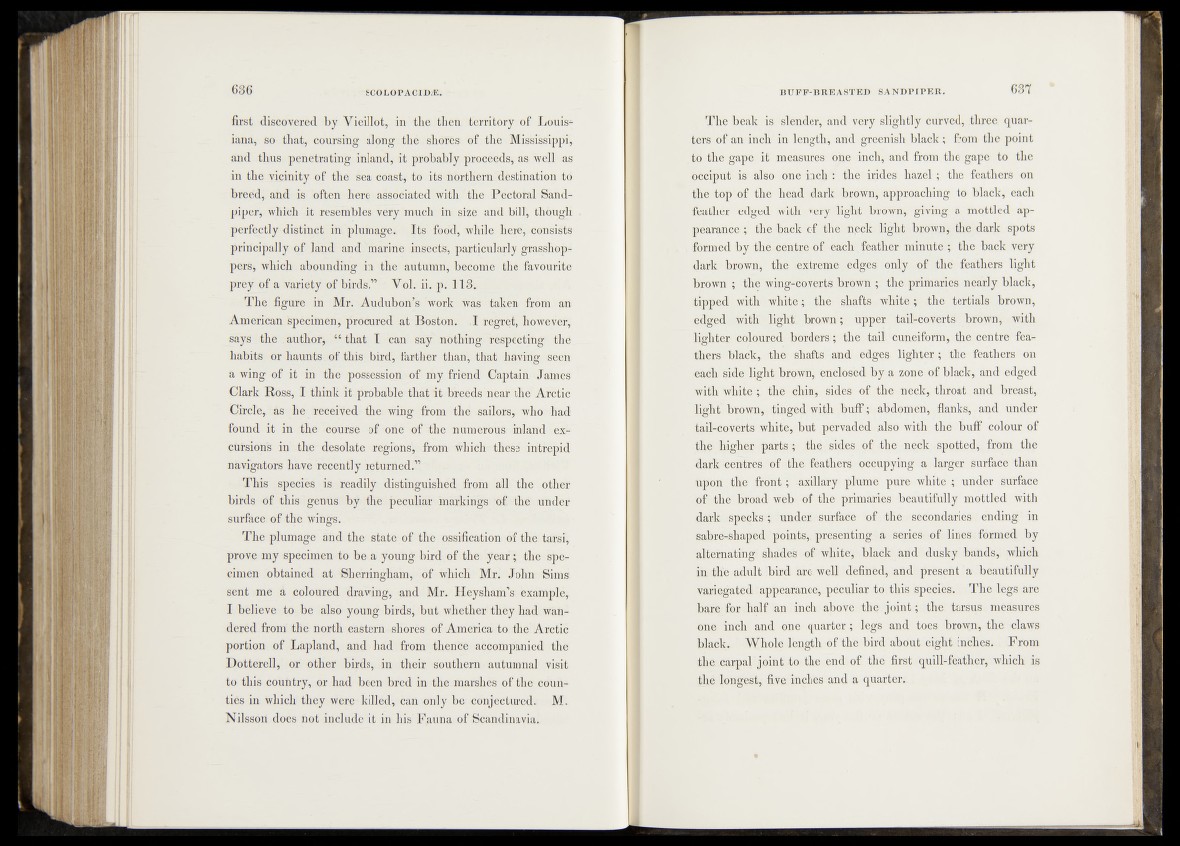
first discovered by Yieillot, in the then territory of Louis11
iana, so that, coursing along the shores of the Mississippi,
and thus penetrating inland, it probably proceeds, as well as
in the vicinity of the sea coast, to its northerndestination to
breed, and is often here associated with the Pectoral Sandpiper,
which it resembles very much in size and. bill, though
perfectly distinct in plumage* Its food, while here, consists"
principally of land and marine insects, particularly grasshoppers,
which abounding in the autumn, become the favourite
prey of a variety of birds.” " Vol.-ii. p. 113.
The figure in Mr. Audubon’s work was taken from an
American specimen, procured at Boston. I regret, however,
says the . author, “ that I can say nothing respecting the
habits or haunts of this bird, farther than, that having seen
a wing of it in the possession of my friend Captain James
Clark Ross, I think it probable that it breeds near the Arctic
Circle, as he received the wing from the sailors, who had
found it in the course of one of the numerous, inland excursions
in the desolate regions, from which these intrepid
navigators have recently returned.”
This species is readily distinguished, from all the other
birds of this genus by the peculiar ‘markings "of the under
surface of the wings..
The plumage and the state of the ossification of the tarsi,
prove my specimen to be a young bird of the year; the specimen
obtained at Sherringham, of which Mr. John Sims
sent me a coloured drawing, and Mr. Heysham’s (example,
I believe to be also young birds, but whether they had wandered
from the north eastern-shores of America to the Arctic
portion of Lapland, and had from thence accompanied the
Dotterell, or other birds, in their southern autumnal visit
to this country, or had been bred in the marshes of the counties
in which they were killed, can only be conjectured. M.
Nilsson does not include it in his Fauna of Scandinavia.,
The beak is slender, and very slightly curved, .three, quarters
of an inch in length, and greenish black; from the point
to the gape it measures one inch, and from the gape to the
occiput is also one inch : the irides hazel; the feathers on
the top of the head dark brown, approaching to black, each
feather edged with very light brown, giving a mottled appearance;
the back of the n,epk light brown, the dark spots
formed by the-centre of each. feather minute ; the back very
dark brown, the extreme edges only of the feathers light
brown ; the wing-coverts brown ; the primaries nearly black,
tipped with white; the shafts white; the tertials brown,
edged with' light brown; upper tail-coverts brown, with
lighter coloured borders; the ta il‘cuneiform* the centre feathers
black, the shafts and edges lighter; the feathers on
each side light brown, enclosed by a zone of black, and edged
with white ; the chin, sides of the neck, throat and breast,
light brown, tinged with buff ; abdomen, flanks, and under
tail-coverts white, but pervaded also with the buff colour of
the higher parts; the sides of the neck spotted, from the
dark centres of the feathers occupying a larger surface than
upon the front; -axillary plume pure white; under surface
of the broad web of the primaries beautifully mottled with
dark specks; under, surface of the secondaries ending in
sabre-shaped points,, presenting a series o f lines , formed by
alternating shades of white, black and dusky bands, which
in the adult bird are, well defined, and present a beautifully
variegated appearance, peculiar to this species. The legs are
bare for half an inch above the jo in t; the tarsus measures
one inch and one quarter; legs and toes brown, the claws
black. Whole length óf the bird about eight inches. From
the carpal joint to the end of the first quill-feather, which is
the longest, five inches and a quarter,.